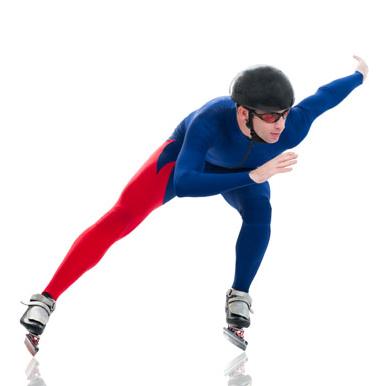
Short track speed skating has been referred to as NASCAR on Ice due to the numerous crashes that can knock even the best competitors out of the race. Megan McNicholl, a physical therapist at ATI Physical Therapy Hillard, OH - Southwest provides a quick primer on the sport and explains that the most common injury in the sport is something not too uncommon in the general public.
Short track speed skating or ‘Short track’ as it is often referred to has gained in popularity over the last few Winter Olympics. Short track made its Olympic debut at the 1992 Olympics and was an instant hit because of its fast paced action. The sport consists of racing on an oval track that is 365.57 feet around that usually doubles as a hockey rink. The course is usually marked out with rubber pylons. Short track competitors race over 500, 1,000 and 1,500 meter distances. They also compete in relays that are 5,000 meters for men and 3,000 meters for women.
Competitors all begin from a standing start and race in a counterclockwise direction. The racers compete to be the first across the finish line but they can incur penalties for interfering with or impeding another skater during the race which results in upward adjustments to their actual completion time. Only light contact is allowed in the sport. The skaters are in crouched positions down straightaways but their bodies slant to an almost horizontal position as they go through the turns. The skaters usually place a hand onto the ice to prevent falling while turning. At this point skaters can easily lose control and will often go sliding into the ice rink’s padded sideboards. When this occurs multiple injuries can result. The two most common injuries that occurred in short track before 2000 were ankle fractures and knee lacerations.
Ankle Fractures:
Many non-athletic people experience ankle fractures whether from slipping, a car accident or misplacing a step when walking. Depending on the severity of the fracture a person may require surgery with placement of retaining screws or a plate, or they may need to wear a walking cast for a few weeks. Typically, physical therapy is recommended after such injuries for patients to regain lost range of motion and strength.
Physical therapists will perform mobilizations to increase movement at the joint in order to improve gait pattern and range of motion of activities such as negotiating stairs and inclines. Therapists will also include strengthening activities to improve ankle stability to improve balance and the ability of the ankle to react properly when on uneven ground. With several months of therapy, many patients are able to return to their previous activity levels.
Speed skaters will undergo similar therapy regimens but their treatment plan will also incorporate return to sport activities that include focusing on regaining their ability to perform at high speeds and the quick reaction times needed at the ankle when training and competing.
If you’re experiencing pain, Complimentary Injury Screenings are available at an ATI Physical Therapy location near you. Call today to schedule yours!
